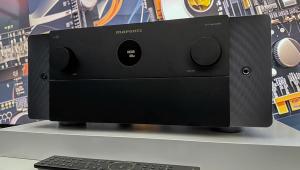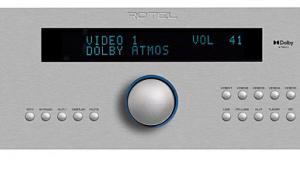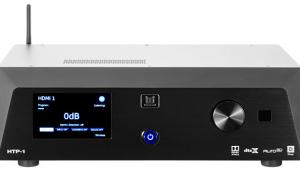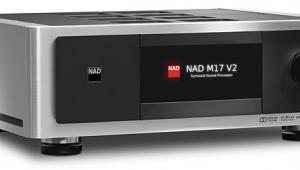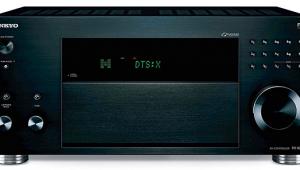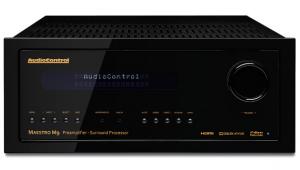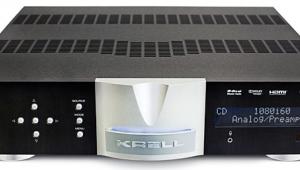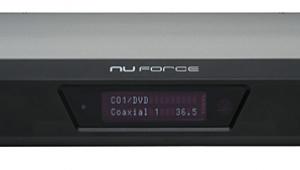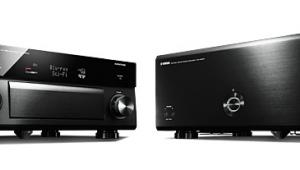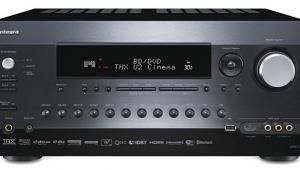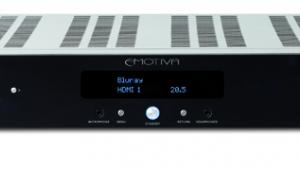David, do you find that the AT IC-6 speakers blend well with the MK system?
Thanks.
Marantz AV8802 Surround Processor Review

AT A GLANCE
Plus
11.1 channels with Audyssey MultEQ XT processing
Dolby Atmos, Auro-3D, and DTS:X surround
Full 4K video processing upgradable to HDCP 2.2
Minus
Limited range for remote sensor
THE VERDICT
Noticeably improved sound quality over its predecessor plus Atmos, Auro-3D, and DTS:X surround processing make the Marantz AV8802 a top-notch upgrade.
It’s been a little more than two years since I reviewed the Marantz AV8801 surround processor, and I liked that model so much, it never left my system. At the time, I thought it was the best-sounding pre/pro I had ever owned, and I had no real desire to upgrade anytime soon. That all changed last fall when Dolby announced that Atmos for the home was on its way. I started thinking how I could finagle four extra speakers into my room—because for some reason, I have this overwhelming desire to stay on the cutting edge of home theater technology, regardless of the personal expense.
Upping the Ante
The AV8801 was tricked out to the nines with virtually every bell and whistle that could be found at the time in a pre/pro, and the same is true of the AV8802. Networking goodies include Apple’s AirPlay, Pandora, SiriusXM, Internet Radio, Spotify Connect, and Flickr. In lieu of the four-port Ethernet hub that was on the AV8801, there’s a single Ethernet jack on the rear, but now you get Wi-Fi and Bluetooth, as well as DLNA 1.5 support for streaming audio files from your local computer network.
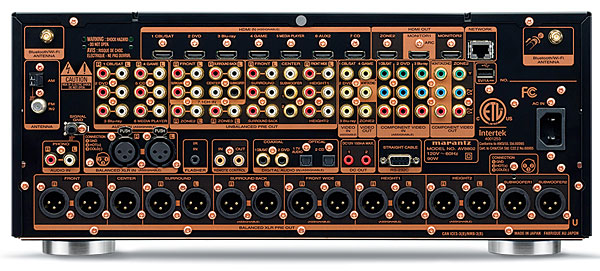
The upgrades don’t stop there. Marantz’s engineers dissected every critical component for the AV8802—including the transformer, the DACs, the HDAMs (the company’s proprietary amplifier modules), and the filter capacitors—and relied on trickle-down technology from the company’s Reference line, specifically the PM-11S3 integrated stereo amplifier. The 11.1-channel preamp section utilizes balanced outputs. Enhancements include brand-new, fully discrete current-feedback HDAM-SA2 modules, along with improved jitter-reduction circuitry for the optical, coaxial, and HDMI inputs. If that’s not enough, the engineers also included a lower-noise toroidal power transformer (derived directly from the PM-11S3), 768-kilohertz/32-bit DACs (AKM4490), and capacitors that have twice the reserve than what was in the vaunted AV8801.
As with its predecessor, the build quality of the AV8802 is outstanding. In addition to the upgrades listed above, the unit has a dual-layer copper chassis that’s carried over from the AV8801, which helps isolate the electronics from outside interference.
If you’ve liked the look of past Marantz AVRs and pre/pros, then you’ll be happy to know that the design philosophy hasn’t changed. The AV8802 has the same classy curved front panel and sparse layout, which includes a volume knob on the right, a source select knob on the left, a power on/standby button, and a simple porthole display showing the selected source and volume level. There’s a flip-down door beneath the porthole that reveals navigation and other controls along with a large traditional LCD. In addition to the plethora of discrete control buttons, there are connectors for HDMI, headphone, Audyssey mic, and auxiliary analog audio/video.
The rear panel is well laid out and accommodates 15 individual balanced and unbalanced output connections. This includes dual subwoofer outputs with XLR and RCA connections for each. These are on a single channel, but there are independent level settings for each subwoofer. Note that even with all these connections, a maximum of 11.1 independent channels may be playing at once. There are seven HDMI 2.0 inputs, three outputs (Monitor 1 with ARC, Monitor 2, and Zone 2), dual component inputs/outputs, and enough gold-plated analog inputs and outputs to satisfy most every audio need you could think of. Rounding out the features on the back panel are a moving-magnet phono input, dual antenna hookups for Wi-Fi and Bluetooth, HD Radio (AM/FM) connection, a single set of XLR balanced inputs, and a second USB input in case you want to permanently attach a storage device loaded with music and photos.
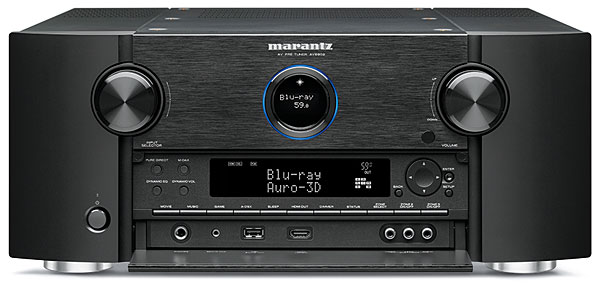
Video processing is handled by an Analog Devices ADV8003 chip, which performs admirably. Additionally, the AV8802 has 4K video processing with the ability to scale current sources to UHD (3840 x 2160), and while the initial units shipping into retail won’t comply with HDCP 2.2, Marantz says it will begin offering a free hardware upgrade at some undesignated point in the future in order to conform with the new copy-protection scheme (you’ll have to pay for one-way shipping). One thing I love about Marantz’s video implementation is the ability to customize the video output by source, so if you want the 1080p/24 signal from your Blu-ray player to be unprocessed but your cable/satellite signal to be upconverted to 1080p or 4K, you can make this choice in the setup menu.
The included remote is competent in its layout and fits nicely in your hand. Thankfully it’s backlit, so it’s easy to see in a darkened room. However, as with my reference Marantz AV8801, the remote sensor on the AV8802 is quite a bit less sensitive than those on my other components, and in my space, it only responds to commands if you are within 15 feet of the unit. While this may not be an issue for most folks, I sometimes watch or listen from an adjoining room, and these pre/pros have been the only pieces in my rack that won’t respond from 16 feet away to either the factory remote or my URC universal. Of course, if you use an RF remote or control system with a receiver hub, it won’t be a problem.
Setting Up
Marantz has the best user interface system I’ve come across (shared by sister company Denon). It’s extremely intuitive, and it looks pretty, too. When you fire up the AV8802 for the first time, a guided setup “assistant” will greet you and walk you through hooking up the various components to your new toy. The only downside of this setup is that I’ve never been a big fan of hooking up wires while the unit is powered up, but if you need it, it’s there. Regardless, once you have all your amplifiers hooked up—I used a total of 11 channels in order to
take full advantage of the Atmos capabilities—you can then perform an Audyssey calibration by plugging the supplied mic into the front of the AV8802.
My first calibration didn’t go very well, with the unit setting my trims much too low, especially for my subwoofers. Perplexed, I ran through the process a second time, which worked perfectly. I may not have had the mic situated properly the first time.
- Log in or register to post comments


Not sure when this review was written, but the Upgrade for HDCP 2.2 starts June 1st the information and forms necessary to complete the process are online on their website.


Hi David. Okay, please do me a favor and ease me off the ledge I'm ready to jump off...I just bought the previous generation 8801 processor. (haven't even unboxed it yet) Are the sonic upgrades enough that I should buy the new one? I'm not ready to go Atmos any time soon, but all the improvements you write about make me wonder if I should just grit my teeth and get the new one. What's your opinion?


Thanks David. Yes, I bought it for 1800.00, so I got a good deal for sure on a great piece. Its actually my first venture into separates, so I was quite excited. But when the new one came out, I turned a little green with envy at the thought of a radical overhaul. I was hoping the difference was going to be just a Dolby Atmos sticker slapped on the front of it, but they hit it out of the park.

I don't mind it when commentators make this mistake, but the reviewer should know better.




So can anyone point to me the benefit of getting this instead of the Onkyo PR-SC5530? Comparing the 2, I was unable to find any thing that The Marantz offers that the Onkyo does not, quite the opposite. So why is this worth $1,500 more?


Yeah, I kind of agree based on what I've seen on forums and such but I've had their very first one (SC885) since 2011 w/o any issues. That and the price difference is just huge. I also missed the Audyssey aspect mentioned by another poster here. I for one would go for the Onkyo sc5509 with Audyssey MultEQ XT 32 /Dynamic EQ & Dynamic Volume, considering I'd never use more than 5 channel surround and to me Atmos and DTS equivalent are no more than gimmiks, but that's just me.


I'm actually hoping for mine to die,(I hate the hassle of selling). I'm researching all available options out there, I usually don't go for the luxury upgrade (Lexus over Toyota, Elite over Pioneer,..etc)but in this case that goes double, The Integras look awful.. this Marantz on the other hand looks gorgeous, but not $1500 worth of gorgeous to me.


I had a mid range TXNR609...very first piece of electronics where I said "YES! It's finally broken!". To say I was disappointed in the performance and operation of this unit would be an understatement. I upgraded to the Marantz SR7007, and haven't regretted it one bit. Now, I did jump up (quite a bit) in cost, but Marantz, in general, will ALWAYS sound better than Onkyo/Integra.

Multiple reasons, some already stated
1. Reliability / Build Quality
2. Room Correction - Audyssey MultiEQ XT32 vs. Onkyo Accu-EQ
3. Onkyo's HDCP 2.2 solution is not full bandwidth and will not do 4:4:4 60hz 4k Video
4. Better User Interface
The forth may be personal opinion, but the rest are pretty substantial reasons to go with the Marantz IMO. I had a DHC 80.3 Integra, and it was a great pre pro, but I think Onkyo/Integra started to go downhill from there.

I've become more interested in DSD recordings which are becoming more plentiful. I didn't see any information on the DACs used in the 8002 and whether the unit will play 64fs, 128fs and 256fs. Could you elaborate on the 8802's ability to play DSDs?

I've got just a 2 (maybe 3) channel system, is a Receiver like this wasted on such a system ?
Any idea how much idle/active power it consumes ? I was attracted to the Pioneer Ice-Power for it's power efficiency. Just wondering how the Marantz compares in efficiency.


4 grand for a unit that can't handle 2 discrete subwoofer channels and will be obsolete in 2 years?
No thanks.

I'm certain it can handle two subs, my 7708 receiver can do that. The price is intimidating though.

It has only one subwoofer channel that has two outputs individual level controls. So you can attach two subs and playback at different levels, but they'll play exactly the same signal. That's
very different from a unit that can set a discrete left and right channel to a pair of subs, band also different from adjusting EQ, distance And phase individually for each sub depending on the effects of the location of each.
It's tough to do because the subs interact with each other in complex ways, but a $4000 pre pro that can't handle this job just isn't acceptable to me.

If it can handle 2 discrete subwoofer channels, then this in the text of the review needs to be clarified:
"This includes dual subwoofer outputs with XLR and RCA connections for each. These are on a single channel, but there are independent level settings for each subwoofer. "


Thanks for the review David. Maybe I am missing it somewhere on the website, but can you please tell me what AMPS you used with your test setup and the Marantz. Thanks



I'm not forking over one more cent for additional surrounds. If the manufacturers want me to inve$t in more channels - then let them get me the two missing front channels that are between the left and center, and the right and center front channels. These front channels have been in most multichannel movies since "Oklahoma!" came out in 1955! No more surrounds! Now,get with it!

Hi David,
After reading the review on the Marantz AV8802 Surround Processor i need to ask a few questions for my next step.
we are building a "home theater" 6.0 m x 4.5m, the speakers are whatmough P series P31, P06, P11 and FX speakers, along a typhoon sub, so 7.1.
my budget had been a round 8k ( pre amp/power amp)+ 1k for cables and install costs for audio only.
Knowing the AV8802 will be around the $3.3k that leaves me $4.7K + install costs for the preamp/power amp.
i will be installing 2 more ceiling speakers to use some of the ATMOS technology, however this can be done a little later.
oh, i can hear the readers saying run the cables while you are doing the install/ Reno, and yes i will run all the wires for future speakers.
My question is if i go down the path of the what would you suggest would complement the 8802 preamp?
I have been steered to Rotel, parasound, then others have suggested Marantz.
Here is my conundrum, which brand will complement the above mentioned (5ch + 2ch,)Power amp giving me 7.1 ch.
or do i purchase 2 x 5 ch, with built in capacity for future speaker installs ( max 3) i know.
any help greatly appreciated.
Steve


David, I really enjoyed reading your review on the Marantz AV8802. In fact, you have helped me finalize my decision on purchasing such a high quality upgrade. Would you care to recommend a few amps that would match the quality of the 8802? I will be utilizing a seven channel system (no Atmos yet :( ). I know I can match the Marantz seven channel amp and get 150 W per channel with a perfectly matching appearance. I was also thinking about going with Emotiva's seven channel amp which I believe will give me 200 W per channel and cost significantly less. Can you help me find an amp of outstanding quality that does not completely break the bank?

My apologies, I overlooked your post about how you're partial to Parasound. I do want to clarify that I'm probably going to be looking for a seven channel amp mainly to conserve shelf space - if I ever decide to go Atmos I would purchase another amp. I don't believe Parasound offers a seven channel amp. That's why I was really thinking about Marantz for the matching looks or Emotiva for the extra power and excellent price. Thoughts?


hello David i've decided to buy a Atoms sound system . i read this well written review and after that i'm in doubt now between Marantz 8802 and Denon AVR-X7200WA with Hdcp 2.2 integrated please tell me which one is more suitable with my TV Samsung UN65JS9500 and Blu-ray Player Pioneer Elite BDP-88FD ? do I also need to buy another Amplifier ? I also need a 7.1 channel speakers ? what are your recommendations ?


David.. Review is very useful.. Currently I have Onkyo NR3030 and enjoying every bit of it.. the show stealer is Dolby Surround Mixer for non Atmos discs.. Have you tested DSU in AV8802? Also, did you experience the DTS Neural surround? An up-mixer solution like DSU

Which amplifier can preferable for klipsch rp280,rp260,rp450..speakers with marantz for 11 channel setup.

Can Some one please elaborate a bit on the Chroma resolution fail? Does this mean that an AV8802 cant pass HDMI video without degrading it?

This post is intended for David Vaughn.
Hi David, I've enjoyed your review on the Marantz AV8802 pre pro that you did last year. Thank you for that. I'm curious how the Marantz AV8802 would compare against the Classe SSP 800, Classe Sigma SSP and the Meridian 861 v8 reference pre pros.
Can you comment on their two-channel performances as well as surround sound performances for movies? I did demo the Meridian 861 v8 reference pre pro, the Classe SSP 800 & the Classe Sigma SSP at my local dealer but not the Marantz. My local dealer does not sell Marantz. They carry the Meridian, Classe, McIntosh, NAD, Rotel, Audio Research, Dan D'Agostino, Linn, Datasat, Theta Digital, etc.
Anyways, the Meridian and both Classe performed fantastic in both two-channel and home theater. The Meridian 861 v8 was superior to both Classe in both two-channel and home theater. It was expected though due to massive price differences between the Meridian 861 v8 and the Classe. I'm not sure if the Marantz AV8802 could compare to the Meridian 861 v8 and the Classe (SSP 800 & Sigma) sonically.
I'm willing to pay for whatever price as long as I can get the best fidelity in both two-channel performance for music and home theater. And I'm not interested in Dolby Atoms, Aura 3D, hdcp 2.2. I don't care about the feature set or bells and whistles. All I care is about the audio fidelity or performances in both two-channel for music and home theater. I currently have the Ayre universal bluray disc player and the Linn Klimax DS digital streamer/DAC as my stereo source for music.
Fyi, I've been using the Linn Kisto pre pro with all Linn amplification and all Linn speaker system for the last 10 years but the Kisto got really outdated. Linn Kisto was Linn's flagship av preamp surround processor but it isn't equipped with hdmi connections because the Kisto was first released before bluray came out.
I had the Ayre bluray player connected to the Linn Kisto via multi-channel analog audio and hdmi out of the Ayre bluray player directly to the TV. Previously I used to have the Linn Unidisk 1.1 universal disc player connected to the Linn Kisto.
Your advise will be greatly appreciated. Thanks in advance.

